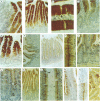Abstract
The rat intestinal fatty acid binding protein (I-FABP) gene exhibits cell-specific as well as regional differences in its expression within the continuously regenerating small intestinal epithelium. To investigate the underlying mechanisms, we linked portions of its 5' nontranscribed domain to the human growth hormone (hGH) gene and analyzed expression of the hGH reporter in transgenic mice by RNA blot, solution hybridization, and immunocytochemical techniques. Sequences located within 277 nucleotides of the start site of I-FABP transcription are sufficient to limit hGH expression to the intestine. Although the absolute levels of hGH mRNA in the duodenum and proximal jejunum of these transgenic mice were similar to those of I-FABP mRNA, steady-state hGH mRNA concentrations were approximately 100 times lower in their distal small intestine. Addition of nucleotides -278 to -1178 of the I-FABP gene "restored" hGH mRNA concentrations in the distal jejunum and ileum to levels comparable to murine I-FABP mRNA. Serum hGH levels were 1000 times lower in the "short promoter" transgenic mice compared to animals with the "long promoter" transgene, indicating that efficient distal small intestinal hGH expression is required to produce elevated hGH concentrations in serum. The distribution of hGH in villus-associated enterocytes and goblet cells and its lack of expression in the crypts of Lieberkuhn mimicked that of the endogenous I-FABP gene product in all transgenic pedigrees. However, bands of hGH-negative cells extending from the base to the tips of villi were frequently observed in mice that were heterozygous for the short promoter transgene. This mosaic staining was not observed for I-FABP. These data suggest that (i) different cis-acting sequences may be required for complete expression of proximal-distal I-FABP gradients than for recapitulation of its normal crypt-villus tip distribution; (ii) differences may exist in the export pathways of secreted proteins within enterocytes located in various regions of the small intestine; and (iii) there may be subtle genetic differences among various crypt stem cells that can be detected in vivo by observing mosaic patterns of transgene expression along the villus epithelium.
Full text
PDF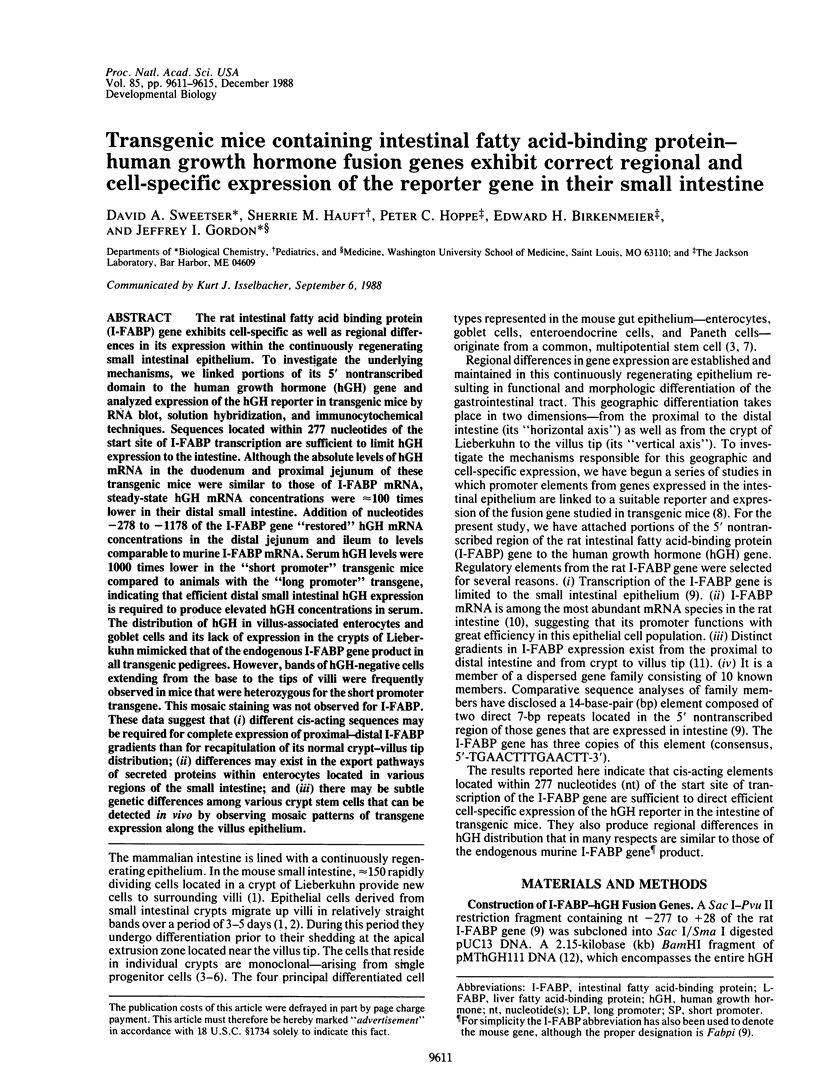
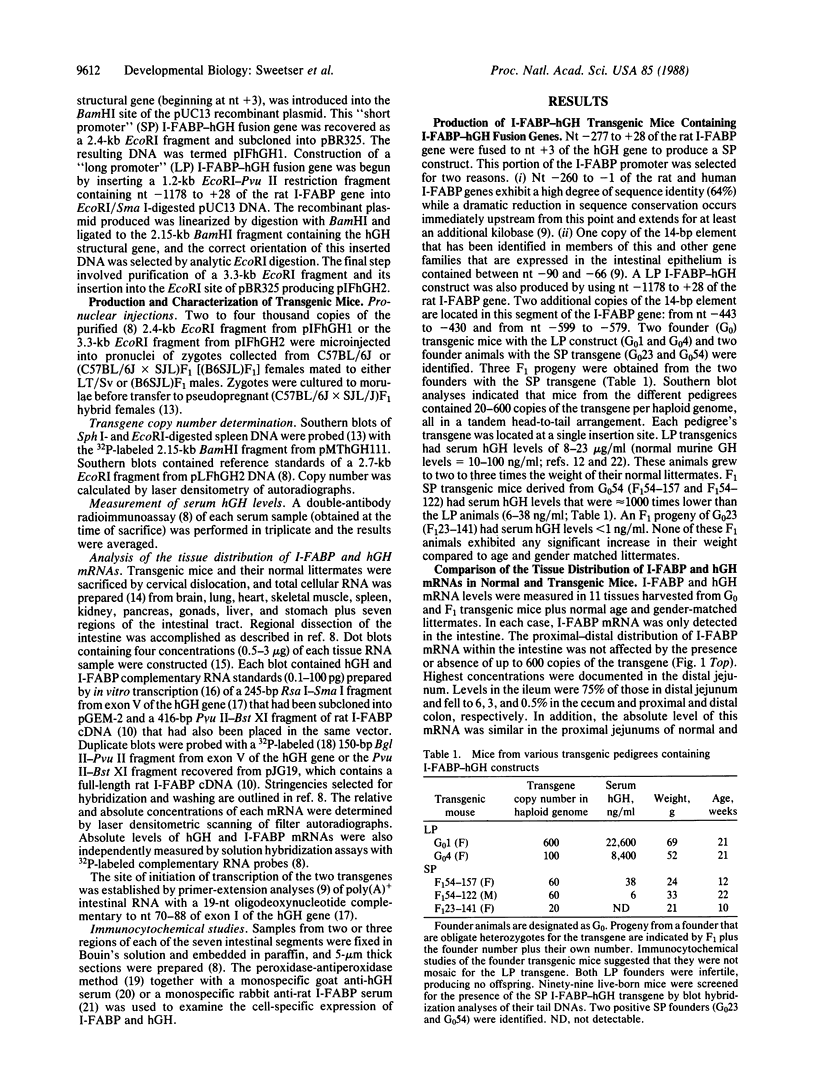
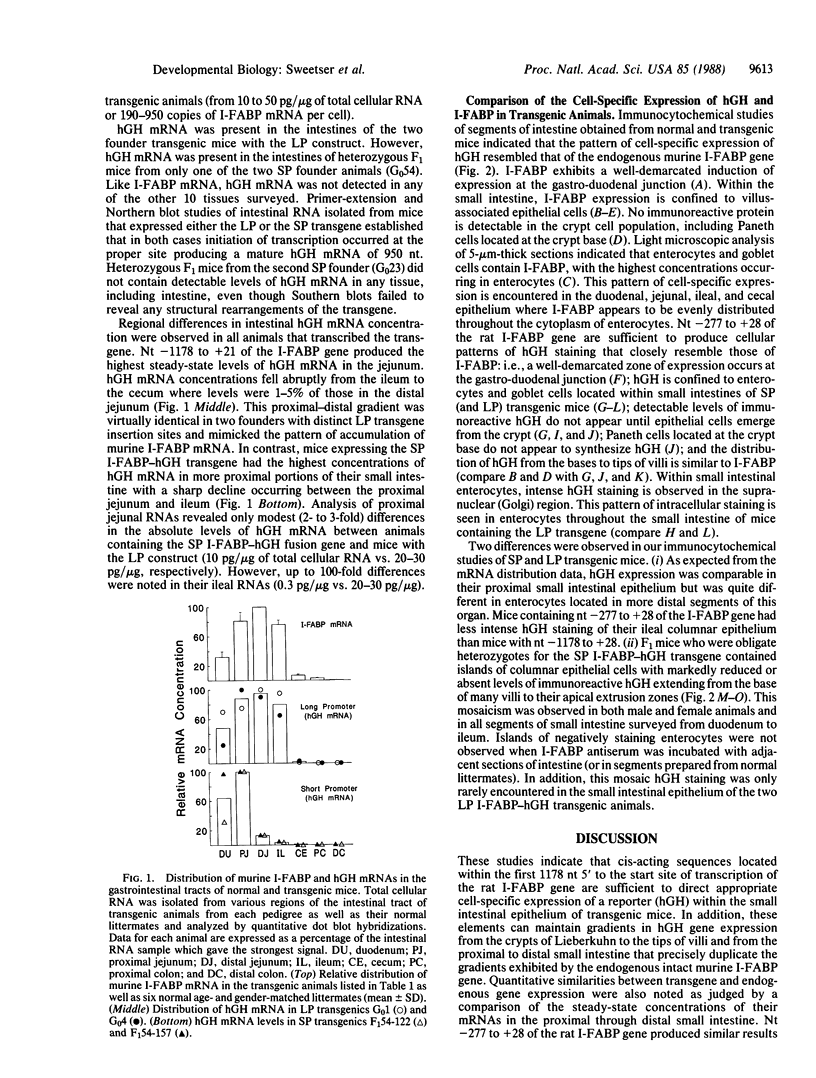
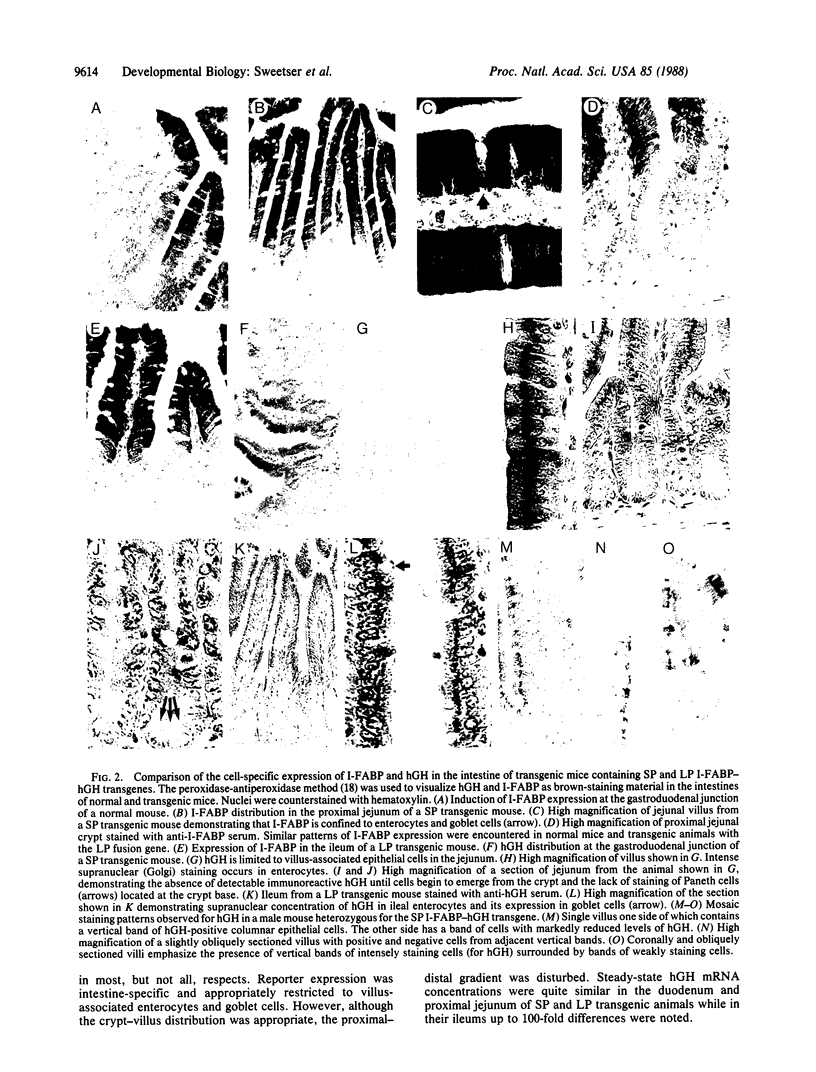
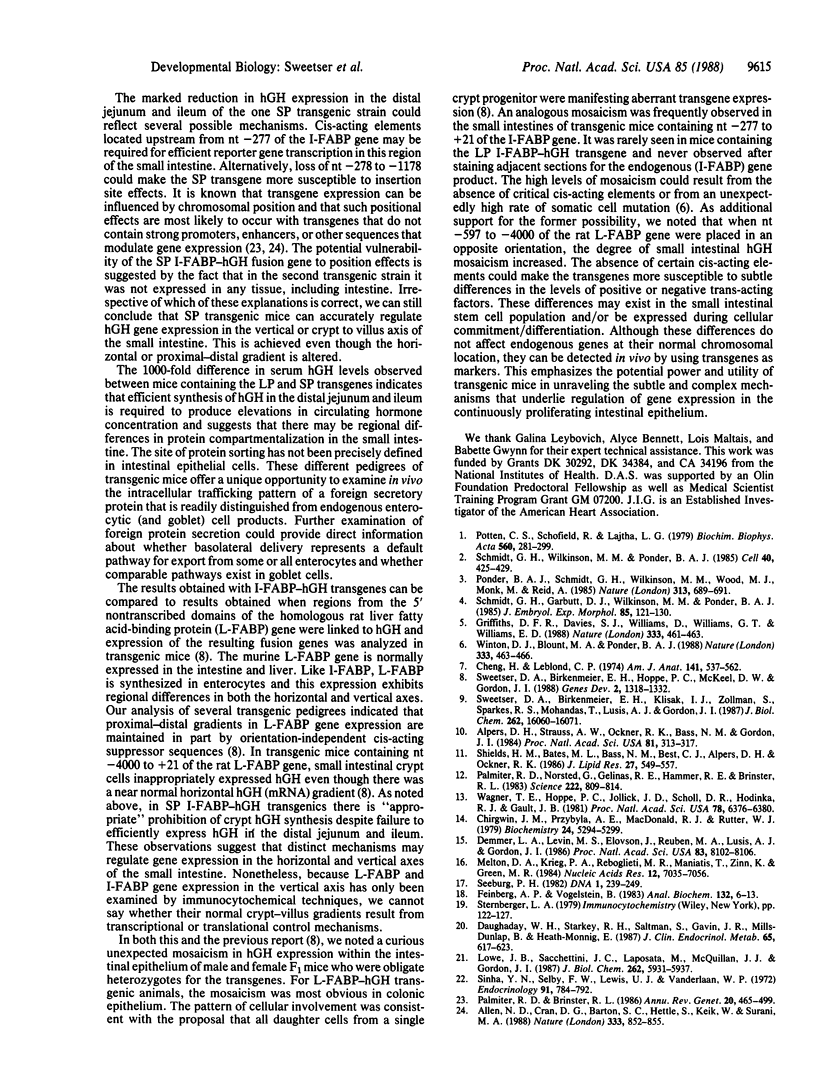
Images in this article
Selected References
These references are in PubMed. This may not be the complete list of references from this article.
- Allen N. D., Cran D. G., Barton S. C., Hettle S., Reik W., Surani M. A. Transgenes as probes for active chromosomal domains in mouse development. Nature. 1988 Jun 30;333(6176):852–855. doi: 10.1038/333852a0. [DOI] [PubMed] [Google Scholar]
- Alpers D. H., Strauss A. W., Ockner R. K., Bass N. M., Gordon J. I. Cloning of a cDNA encoding rat intestinal fatty acid binding protein. Proc Natl Acad Sci U S A. 1984 Jan;81(2):313–317. doi: 10.1073/pnas.81.2.313. [DOI] [PMC free article] [PubMed] [Google Scholar]
- Cheng H., Leblond C. P. Origin, differentiation and renewal of the four main epithelial cell types in the mouse small intestine. V. Unitarian Theory of the origin of the four epithelial cell types. Am J Anat. 1974 Dec;141(4):537–561. doi: 10.1002/aja.1001410407. [DOI] [PubMed] [Google Scholar]
- Chirgwin J. M., Przybyla A. E., MacDonald R. J., Rutter W. J. Isolation of biologically active ribonucleic acid from sources enriched in ribonuclease. Biochemistry. 1979 Nov 27;18(24):5294–5299. doi: 10.1021/bi00591a005. [DOI] [PubMed] [Google Scholar]
- Daughaday W. H., Starkey R. H., Saltman S., Gavin J. R., 3rd, Mills-Dunlap B., Heath-Monnig E. Characterization of serum growth hormone (GH) and insulin-like growth factor I in active acromegaly with minimal elevation of serum GH. J Clin Endocrinol Metab. 1987 Oct;65(4):617–623. doi: 10.1210/jcem-65-4-617. [DOI] [PubMed] [Google Scholar]
- Demmer L. A., Levin M. S., Elovson J., Reuben M. A., Lusis A. J., Gordon J. I. Tissue-specific expression and developmental regulation of the rat apolipoprotein B gene. Proc Natl Acad Sci U S A. 1986 Nov;83(21):8102–8106. doi: 10.1073/pnas.83.21.8102. [DOI] [PMC free article] [PubMed] [Google Scholar]
- Feinberg A. P., Vogelstein B. A technique for radiolabeling DNA restriction endonuclease fragments to high specific activity. Anal Biochem. 1983 Jul 1;132(1):6–13. doi: 10.1016/0003-2697(83)90418-9. [DOI] [PubMed] [Google Scholar]
- Griffiths D. F., Davies S. J., Williams D., Williams G. T., Williams E. D. Demonstration of somatic mutation and colonic crypt clonality by X-linked enzyme histochemistry. Nature. 1988 Jun 2;333(6172):461–463. doi: 10.1038/333461a0. [DOI] [PubMed] [Google Scholar]
- Lowe J. B., Sacchettini J. C., Laposata M., McQuillan J. J., Gordon J. I. Expression of rat intestinal fatty acid-binding protein in Escherichia coli. Purification and comparison of ligand binding characteristics with that of Escherichia coli-derived rat liver fatty acid-binding protein. J Biol Chem. 1987 Apr 25;262(12):5931–5937. [PubMed] [Google Scholar]
- Melton D. A., Krieg P. A., Rebagliati M. R., Maniatis T., Zinn K., Green M. R. Efficient in vitro synthesis of biologically active RNA and RNA hybridization probes from plasmids containing a bacteriophage SP6 promoter. Nucleic Acids Res. 1984 Sep 25;12(18):7035–7056. doi: 10.1093/nar/12.18.7035. [DOI] [PMC free article] [PubMed] [Google Scholar]
- Palmiter R. D., Brinster R. L. Germ-line transformation of mice. Annu Rev Genet. 1986;20:465–499. doi: 10.1146/annurev.ge.20.120186.002341. [DOI] [PMC free article] [PubMed] [Google Scholar]
- Palmiter R. D., Norstedt G., Gelinas R. E., Hammer R. E., Brinster R. L. Metallothionein-human GH fusion genes stimulate growth of mice. Science. 1983 Nov 18;222(4625):809–814. doi: 10.1126/science.6356363. [DOI] [PubMed] [Google Scholar]
- Ponder B. A., Schmidt G. H., Wilkinson M. M., Wood M. J., Monk M., Reid A. Derivation of mouse intestinal crypts from single progenitor cells. Nature. 1985 Feb 21;313(6004):689–691. doi: 10.1038/313689a0. [DOI] [PubMed] [Google Scholar]
- Potten C. S., Schofield R., Lajtha L. G. A comparison of cell replacement in bone marrow, testis and three regions of surface epithelium. Biochim Biophys Acta. 1979 Aug 10;560(2):281–299. doi: 10.1016/0304-419x(79)90022-2. [DOI] [PubMed] [Google Scholar]
- Schmidt G. H., Garbutt D. J., Wilkinson M. M., Ponder B. A. Clonal analysis of intestinal crypt populations in mouse aggregation chimaeras. J Embryol Exp Morphol. 1985 Feb;85:121–130. [PubMed] [Google Scholar]
- Schmidt G. H., Wilkinson M. M., Ponder B. A. Cell migration pathway in the intestinal epithelium: an in situ marker system using mouse aggregation chimeras. Cell. 1985 Feb;40(2):425–429. doi: 10.1016/0092-8674(85)90156-4. [DOI] [PubMed] [Google Scholar]
- Seeburg P. H. The human growth hormone gene family: nucleotide sequences show recent divergence and predict a new polypeptide hormone. DNA. 1982;1(3):239–249. doi: 10.1089/dna.1.1982.1.239. [DOI] [PubMed] [Google Scholar]
- Shields H. M., Bates M. L., Bass N. M., Best C. J., Alpers D. H., Ockner R. K. Light microscopic immunocytochemical localization of hepatic and intestinal types of fatty acid-binding proteins in rat small intestine. J Lipid Res. 1986 May;27(5):549–557. [PubMed] [Google Scholar]
- Sinha Y. N., Selby F. W., Lewis U. J., VanderLaan W. P. Studies of GH secretion in mice by a homologous radioimmunoassay for mouse GH. Endocrinology. 1972 Sep;91(3):784–792. doi: 10.1210/endo-91-3-784. [DOI] [PubMed] [Google Scholar]
- Sweetser D. A., Birkenmeier E. H., Hoppe P. C., McKeel D. W., Gordon J. I. Mechanisms underlying generation of gradients in gene expression within the intestine: an analysis using transgenic mice containing fatty acid binding protein-human growth hormone fusion genes. Genes Dev. 1988 Oct;2(10):1318–1332. doi: 10.1101/gad.2.10.1318. [DOI] [PubMed] [Google Scholar]
- Sweetser D. A., Birkenmeier E. H., Klisak I. J., Zollman S., Sparkes R. S., Mohandas T., Lusis A. J., Gordon J. I. The human and rodent intestinal fatty acid binding protein genes. A comparative analysis of their structure, expression, and linkage relationships. J Biol Chem. 1987 Nov 25;262(33):16060–16071. [PubMed] [Google Scholar]
- Wagner T. E., Hoppe P. C., Jollick J. D., Scholl D. R., Hodinka R. L., Gault J. B. Microinjection of a rabbit beta-globin gene into zygotes and its subsequent expression in adult mice and their offspring. Proc Natl Acad Sci U S A. 1981 Oct;78(10):6376–6380. doi: 10.1073/pnas.78.10.6376. [DOI] [PMC free article] [PubMed] [Google Scholar]
- Winton D. J., Blount M. A., Ponder B. A. A clonal marker induced by mutation in mouse intestinal epithelium. Nature. 1988 Jun 2;333(6172):463–466. doi: 10.1038/333463a0. [DOI] [PubMed] [Google Scholar]



